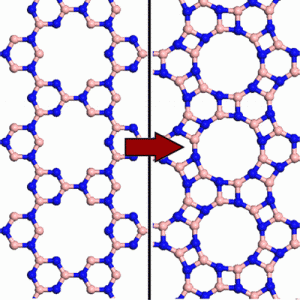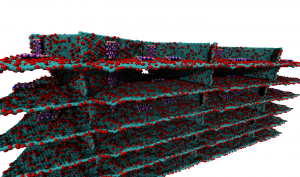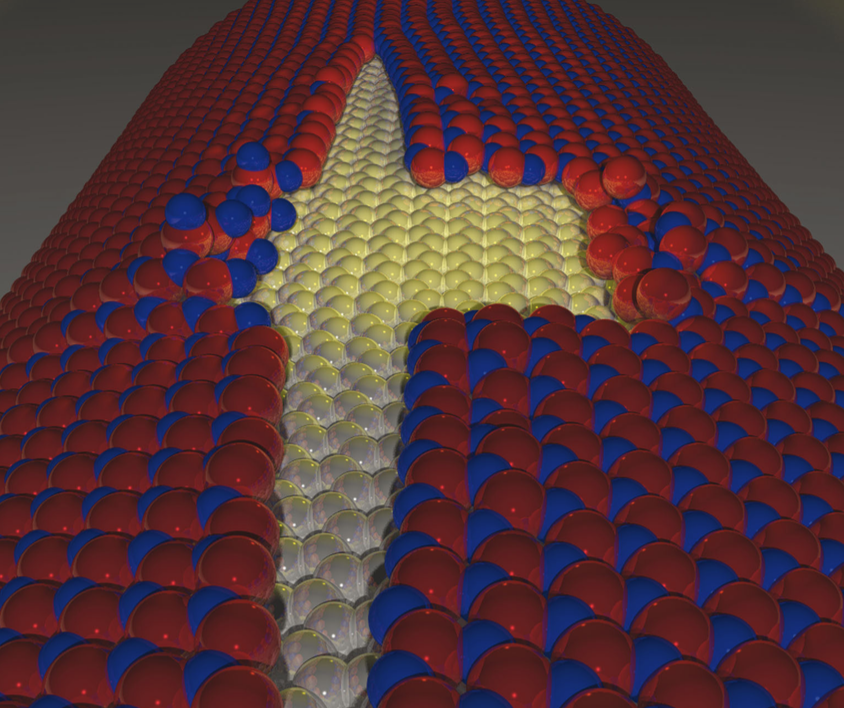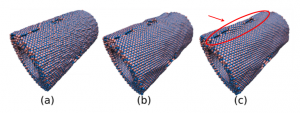Gao, Guanhui; Mathkar, Akshay; Martins, Eric Perim; Galv ao, Douglas S; Gao, Duyang; da Silva Autreto, Pedro Alves; Sun, Chengjun; Cai, Lintao; Ajayan, Pulickel M
Designing nanoscaled hybrids from atomic layered boron nitride with silver nanoparticle deposition Journal Article
Em: Journal of Materials Chemistry A, vol. 2, não 9, pp. 3148–3154, 2014.
@article{gao2014designing,
title = {Designing nanoscaled hybrids from atomic layered boron nitride with silver nanoparticle deposition},
author = {Gao, Guanhui and Mathkar, Akshay and Martins, Eric Perim and Galv~ao, Douglas S and Gao, Duyang and da Silva Autreto, Pedro Alves and Sun, Chengjun and Cai, Lintao and Ajayan, Pulickel M},
url = {http://pubs.rsc.org/en/Content/ArticleLanding/2014/TA/c3ta12892j#!divAbstract},
year = {2014},
date = {2014-01-01},
journal = {Journal of Materials Chemistry A},
volume = {2},
number = {9},
pages = {3148--3154},
publisher = {Royal Society of Chemistry},
abstract = {We have developed a microwave assisted one-pot approach to fabricate a novel hybrid nano-composite composed of two-dimensional chemically exfoliated layered hexagonal boron nitride (h-BN) and embedded silver nanoparticles (SNP). Atomic layered h-BN exfoliated using chemical liquid showed strong in-plane bonding and weak van der Waals interplanar interactions, which is utilized for chemically interfacing SNP, indicating their ability to act as excellent nano-scaffolds. The SNP/h-BN optical response, in particular band gap, is strongly dependent on the concentration of the metallic particles. In order to gain further insight into this behavior we have also carried out ab initio density functional theory (DFT) calculations on modeled structures, demonstrating that the bandgap value of SNP/h-BN hybrids could be significantly altered by a small percentage of OH− groups located at dangling B and N atoms. Our results showed that these novel SNP/h-BN nanohybrid structures exhibited excellent thermal stability and they are expected to be applied as devices for thermal oxidation-resistant surface enhanced Raman spectroscopy (SERS). The SNP/h-BN membrane showed remarkable antibacterial activity, suggesting their potential use in water disinfection and food packaging.},
keywords = {},
pubstate = {published},
tppubtype = {article}
}
Perim Martins, Eric; Paupitz, Ricardo; Autreto, Pedro Alves da Silva; Galvao, Douglas Soares
Inorganic Graphenylene: A Porous Two-Dimensional Material with Tunable Band Gap Journal Article
Em: The Journal of Physical Chemistry C, vol. 118, não 41, pp. 23670–23674, 2014.
@article{perim2014inorganic,
title = {Inorganic Graphenylene: A Porous Two-Dimensional Material with Tunable Band Gap},
author = {Perim Martins, Eric and Paupitz, Ricardo and Autreto, Pedro Alves da Silva and Galvao, Douglas Soares},
url = {http://pubs.acs.org/doi/abs/10.1021/jp502119y},
year = {2014},
date = {2014-01-01},
journal = {The Journal of Physical Chemistry C},
volume = {118},
number = {41},
pages = {23670–23674},
publisher = {American Chemical Society},
abstract = {By means of ab initio calculations, we investigate the possibility of existence of a boron nitride (BN) porous two-dimensional nanosheet, which is geometrically similar to the carbon allotrope known as biphenylene carbon. The proposed structure, which we called inorganic graphenylene (IGP), is formed spontaneously after selective dehydrogenation of the porous boron nitride (BN) structure proposed by Ding et al. We study the structural and electronic properties of both porous BN and IGP, and it is shown that, by selective substitution of B and N atoms with carbon atoms in these structures, the band gap can be significantly reduced, changing their behavior from insulators to semiconductors, thus opening the possibility of band gap engineering for this class of two-dimensional materials.},
keywords = {},
pubstate = {published},
tppubtype = {article}
}
Vinod, Soumya; Tiwary, Chandra Sekhar; da Silva Autreto, Pedro Alves; Taha-Tijerina, Jaime; Ozden, Sehmus; Chipara, Alin Cristian; Vajtai, Robert; Galvao, Douglas S; Narayanan, Tharangattu N; Ajayan, Pulickel M
Low-density three-dimensional foam using self-reinforced hybrid two-dimensional atomic layers Journal Article
Em: Nature communications, vol. 5, 2014.
@article{Vinod2014,
title = {Low-density three-dimensional foam using self-reinforced hybrid two-dimensional atomic layers},
author = {Vinod, Soumya and Tiwary, Chandra Sekhar and da Silva Autreto, Pedro Alves and Taha-Tijerina, Jaime and Ozden, Sehmus and Chipara, Alin Cristian and Vajtai, Robert and Galvao, Douglas S and Narayanan, Tharangattu N and Ajayan, Pulickel M},
url = {http://www.nature.com/ncomms/2014/140729/ncomms5541/full/ncomms5541.html},
year = {2014},
date = {2014-01-01},
journal = {Nature communications},
volume = {5},
publisher = {Nature Publishing Group},
abstract = {Low-density nanostructured foams are often limited in applications due to their low mechanical and thermal stabilities. Here we report an approach of building the structural units of three-dimensional (3D) foams using hybrid two-dimensional (2D) atomic layers made of stacked graphene oxide layers reinforced with conformal hexagonal boron nitride (h-BN) platelets. The ultra-low density (1/400 times density of graphite) 3D porous structures are scalably synthesized using solution processing method. A layered 3D foam structure forms due to presence of h-BN and significant improvements in the mechanical properties are observed for the hybrid foam structures, over a range of temperatures, compared with pristine graphene oxide or reduced graphene oxide foams. It is found that domains of h-BN layers on the graphene oxide framework help to reinforce the 2D structural units, providing the observed improvement in mechanical integrity of the 3D foam structure.},
keywords = {},
pubstate = {published},
tppubtype = {article}
}
Perim, E; Autreto, PAS; Paupitz, R; Galvao, DS
Dynamical aspects of the unzipping of multiwalled boron nitride nanotubes Journal Article
Em: Physical Chemistry Chemical Physics, vol. 15, não 44, pp. 19147–19150, 2013.
@article{perim2013dynamical,
title = {Dynamical aspects of the unzipping of multiwalled boron nitride nanotubes},
author = {Perim, E and Autreto, PAS and Paupitz, R and Galvao, DS},
year = {2013},
date = {2013-01-01},
journal = {Physical Chemistry Chemical Physics},
volume = {15},
number = {44},
pages = {19147--19150},
publisher = {Royal Society of Chemistry},
abstract = {Boron nitride nanoribbons (BNNRs) exhibit very interesting magnetic properties, which could be very useful in the development of spintronic based devices. One possible route to obtain BNNRs is through the unzipping of boron nitride nanotubes (BNNTs), which have been already experimentally realized. In this work, different aspects of the unzipping process of BNNTs were investigated through fully atomistic molecular dynamics simulations using a classical reactive force field (ReaxFF). We investigated multiwalled BNNTs of different diameters and chiralities. Our results show that chirality plays a very important role in the unzipping process, as well as the interlayer coupling. These combined aspects significantly change the fracturing patterns and several other features of the unzipping processes in comparison to the ones observed for carbon nanotubes. Also, similar to carbon nanotubes, defective BNNTs can create regions of very high curvature which can act as a path to the unzipping process.},
keywords = {},
pubstate = {published},
tppubtype = {article}
}
Perim, Eric; Santos, Ricardo Paupitz; Autreto, Pedro Alves da Silva; Galvao, Douglas S
Fracture Patterns of Boron Nitride Nanotubes Journal Article
Em: MRS Proceedings, vol. 1526, pp. mrsf12–1526, 2013.
@article{Perim2013,
title = {Fracture Patterns of Boron Nitride Nanotubes},
author = {Perim, Eric and Santos, Ricardo Paupitz and Autreto, Pedro Alves da Silva and Galvao, Douglas S},
year = {2013},
date = {2013-01-01},
journal = {MRS Proceedings},
volume = {1526},
pages = {mrsf12--1526},
publisher = {Cambridge University Press},
keywords = {},
pubstate = {published},
tppubtype = {article}
}
Perim, Eric; Paupitz, Ricardo; Autreto, PAS; Galvao, DS
The Hydrogenation Dynamics of h-BN Sheets Journal Article
Em: MRS Proceedings, vol. 1549, pp. 91–98, 2013.
@article{perim2013hydrogenation,
title = {The Hydrogenation Dynamics of h-BN Sheets},
author = {Perim, Eric and Paupitz, Ricardo and Autreto, PAS and Galvao, DS},
url = {http://journals.cambridge.org/action/displayAbstract?fromPage=online&aid=8943477&fileId=S1946427413007938},
year = {2013},
date = {2013-01-01},
journal = {MRS Proceedings},
volume = {1549},
pages = {91--98},
publisher = {Cambridge University Press},
abstract = {Hexagonal boron nitride (h-BN), also known as white graphite, is the inorganic analogue of graphite. Single layers of both structures have been already experimentally realized.
In this work we have investigated, through fully atomistic reactive molecular dynamics simulations, the dynamics of hydrogenation of h-BN single-layers membranes.
Our results show that the rate of hydrogenation atoms bonded to the membrane is highly dependent on the temperature and that only at low temperatures there is a preferential bond to boron atoms. Unlike graphanes (hydrogenated graphene), hydrogenated h-BN membranes do not exhibit the formation of correlated domains. Also, the out-of-plane deformations are more pronounced in comparison with the graphene case. After a critical number of incorporated hydrogen atoms the membrane become increasingly defective, lost its two-dimensional character and collapses. The hydrogen radial pair distribution and second-nearest neighbor correlations were also analyzed.},
keywords = {},
pubstate = {published},
tppubtype = {article}
}
In this work we have investigated, through fully atomistic reactive molecular dynamics simulations, the dynamics of hydrogenation of h-BN single-layers membranes.
Our results show that the rate of hydrogenation atoms bonded to the membrane is highly dependent on the temperature and that only at low temperatures there is a preferential bond to boron atoms. Unlike graphanes (hydrogenated graphene), hydrogenated h-BN membranes do not exhibit the formation of correlated domains. Also, the out-of-plane deformations are more pronounced in comparison with the graphene case. After a critical number of incorporated hydrogen atoms the membrane become increasingly defective, lost its two-dimensional character and collapses. The hydrogen radial pair distribution and second-nearest neighbor correlations were also analyzed.
2014

Gao, Guanhui; Mathkar, Akshay; Martins, Eric Perim; Galv ao, Douglas S; Gao, Duyang; da Silva Autreto, Pedro Alves; Sun, Chengjun; Cai, Lintao; Ajayan, Pulickel M
Designing nanoscaled hybrids from atomic layered boron nitride with silver nanoparticle deposition Journal Article
Em: Journal of Materials Chemistry A, vol. 2, não 9, pp. 3148–3154, 2014.
Resumo | Links | BibTeX | Tags: biology, boron nitride, graphene
@article{gao2014designing,
title = {Designing nanoscaled hybrids from atomic layered boron nitride with silver nanoparticle deposition},
author = {Gao, Guanhui and Mathkar, Akshay and Martins, Eric Perim and Galv~ao, Douglas S and Gao, Duyang and da Silva Autreto, Pedro Alves and Sun, Chengjun and Cai, Lintao and Ajayan, Pulickel M},
url = {http://pubs.rsc.org/en/Content/ArticleLanding/2014/TA/c3ta12892j#!divAbstract},
year = {2014},
date = {2014-01-01},
journal = {Journal of Materials Chemistry A},
volume = {2},
number = {9},
pages = {3148--3154},
publisher = {Royal Society of Chemistry},
abstract = {We have developed a microwave assisted one-pot approach to fabricate a novel hybrid nano-composite composed of two-dimensional chemically exfoliated layered hexagonal boron nitride (h-BN) and embedded silver nanoparticles (SNP). Atomic layered h-BN exfoliated using chemical liquid showed strong in-plane bonding and weak van der Waals interplanar interactions, which is utilized for chemically interfacing SNP, indicating their ability to act as excellent nano-scaffolds. The SNP/h-BN optical response, in particular band gap, is strongly dependent on the concentration of the metallic particles. In order to gain further insight into this behavior we have also carried out ab initio density functional theory (DFT) calculations on modeled structures, demonstrating that the bandgap value of SNP/h-BN hybrids could be significantly altered by a small percentage of OH− groups located at dangling B and N atoms. Our results showed that these novel SNP/h-BN nanohybrid structures exhibited excellent thermal stability and they are expected to be applied as devices for thermal oxidation-resistant surface enhanced Raman spectroscopy (SERS). The SNP/h-BN membrane showed remarkable antibacterial activity, suggesting their potential use in water disinfection and food packaging.},
keywords = {biology, boron nitride, graphene},
pubstate = {published},
tppubtype = {article}
}

Perim Martins, Eric; Paupitz, Ricardo; Autreto, Pedro Alves da Silva; Galvao, Douglas Soares
Inorganic Graphenylene: A Porous Two-Dimensional Material with Tunable Band Gap Journal Article
Em: The Journal of Physical Chemistry C, vol. 118, não 41, pp. 23670–23674, 2014.
Resumo | Links | BibTeX | Tags: boron nitride, molecular dynamics, porous graphene
@article{perim2014inorganic,
title = {Inorganic Graphenylene: A Porous Two-Dimensional Material with Tunable Band Gap},
author = {Perim Martins, Eric and Paupitz, Ricardo and Autreto, Pedro Alves da Silva and Galvao, Douglas Soares},
url = {http://pubs.acs.org/doi/abs/10.1021/jp502119y},
year = {2014},
date = {2014-01-01},
journal = {The Journal of Physical Chemistry C},
volume = {118},
number = {41},
pages = {23670–23674},
publisher = {American Chemical Society},
abstract = {By means of ab initio calculations, we investigate the possibility of existence of a boron nitride (BN) porous two-dimensional nanosheet, which is geometrically similar to the carbon allotrope known as biphenylene carbon. The proposed structure, which we called inorganic graphenylene (IGP), is formed spontaneously after selective dehydrogenation of the porous boron nitride (BN) structure proposed by Ding et al. We study the structural and electronic properties of both porous BN and IGP, and it is shown that, by selective substitution of B and N atoms with carbon atoms in these structures, the band gap can be significantly reduced, changing their behavior from insulators to semiconductors, thus opening the possibility of band gap engineering for this class of two-dimensional materials.},
keywords = {boron nitride, molecular dynamics, porous graphene},
pubstate = {published},
tppubtype = {article}
}

Vinod, Soumya; Tiwary, Chandra Sekhar; da Silva Autreto, Pedro Alves; Taha-Tijerina, Jaime; Ozden, Sehmus; Chipara, Alin Cristian; Vajtai, Robert; Galvao, Douglas S; Narayanan, Tharangattu N; Ajayan, Pulickel M
Low-density three-dimensional foam using self-reinforced hybrid two-dimensional atomic layers Journal Article
Em: Nature communications, vol. 5, 2014.
Resumo | Links | BibTeX | Tags: boron nitride, foams, graphene, molecular dynamics
@article{Vinod2014,
title = {Low-density three-dimensional foam using self-reinforced hybrid two-dimensional atomic layers},
author = {Vinod, Soumya and Tiwary, Chandra Sekhar and da Silva Autreto, Pedro Alves and Taha-Tijerina, Jaime and Ozden, Sehmus and Chipara, Alin Cristian and Vajtai, Robert and Galvao, Douglas S and Narayanan, Tharangattu N and Ajayan, Pulickel M},
url = {http://www.nature.com/ncomms/2014/140729/ncomms5541/full/ncomms5541.html},
year = {2014},
date = {2014-01-01},
journal = {Nature communications},
volume = {5},
publisher = {Nature Publishing Group},
abstract = {Low-density nanostructured foams are often limited in applications due to their low mechanical and thermal stabilities. Here we report an approach of building the structural units of three-dimensional (3D) foams using hybrid two-dimensional (2D) atomic layers made of stacked graphene oxide layers reinforced with conformal hexagonal boron nitride (h-BN) platelets. The ultra-low density (1/400 times density of graphite) 3D porous structures are scalably synthesized using solution processing method. A layered 3D foam structure forms due to presence of h-BN and significant improvements in the mechanical properties are observed for the hybrid foam structures, over a range of temperatures, compared with pristine graphene oxide or reduced graphene oxide foams. It is found that domains of h-BN layers on the graphene oxide framework help to reinforce the 2D structural units, providing the observed improvement in mechanical integrity of the 3D foam structure.},
keywords = {boron nitride, foams, graphene, molecular dynamics},
pubstate = {published},
tppubtype = {article}
}
2013

Perim, E; Autreto, PAS; Paupitz, R; Galvao, DS
Dynamical aspects of the unzipping of multiwalled boron nitride nanotubes Journal Article
Em: Physical Chemistry Chemical Physics, vol. 15, não 44, pp. 19147–19150, 2013.
Resumo | BibTeX | Tags: boron nitride, molecular dynamics, reaxFF
@article{perim2013dynamical,
title = {Dynamical aspects of the unzipping of multiwalled boron nitride nanotubes},
author = {Perim, E and Autreto, PAS and Paupitz, R and Galvao, DS},
year = {2013},
date = {2013-01-01},
journal = {Physical Chemistry Chemical Physics},
volume = {15},
number = {44},
pages = {19147--19150},
publisher = {Royal Society of Chemistry},
abstract = {Boron nitride nanoribbons (BNNRs) exhibit very interesting magnetic properties, which could be very useful in the development of spintronic based devices. One possible route to obtain BNNRs is through the unzipping of boron nitride nanotubes (BNNTs), which have been already experimentally realized. In this work, different aspects of the unzipping process of BNNTs were investigated through fully atomistic molecular dynamics simulations using a classical reactive force field (ReaxFF). We investigated multiwalled BNNTs of different diameters and chiralities. Our results show that chirality plays a very important role in the unzipping process, as well as the interlayer coupling. These combined aspects significantly change the fracturing patterns and several other features of the unzipping processes in comparison to the ones observed for carbon nanotubes. Also, similar to carbon nanotubes, defective BNNTs can create regions of very high curvature which can act as a path to the unzipping process.},
keywords = {boron nitride, molecular dynamics, reaxFF},
pubstate = {published},
tppubtype = {article}
}

Perim, Eric; Santos, Ricardo Paupitz; Autreto, Pedro Alves da Silva; Galvao, Douglas S
Fracture Patterns of Boron Nitride Nanotubes Journal Article
Em: MRS Proceedings, vol. 1526, pp. mrsf12–1526, 2013.
BibTeX | Tags: boron nitride, graphene, molecular dynamics
@article{Perim2013,
title = {Fracture Patterns of Boron Nitride Nanotubes},
author = {Perim, Eric and Santos, Ricardo Paupitz and Autreto, Pedro Alves da Silva and Galvao, Douglas S},
year = {2013},
date = {2013-01-01},
journal = {MRS Proceedings},
volume = {1526},
pages = {mrsf12--1526},
publisher = {Cambridge University Press},
keywords = {boron nitride, graphene, molecular dynamics},
pubstate = {published},
tppubtype = {article}
}

Perim, Eric; Paupitz, Ricardo; Autreto, PAS; Galvao, DS
The Hydrogenation Dynamics of h-BN Sheets Journal Article
Em: MRS Proceedings, vol. 1549, pp. 91–98, 2013.
Resumo | Links | BibTeX | Tags: boron nitride, molecular dynamics, reaxFF
@article{perim2013hydrogenation,
title = {The Hydrogenation Dynamics of h-BN Sheets},
author = {Perim, Eric and Paupitz, Ricardo and Autreto, PAS and Galvao, DS},
url = {http://journals.cambridge.org/action/displayAbstract?fromPage=online&aid=8943477&fileId=S1946427413007938},
year = {2013},
date = {2013-01-01},
journal = {MRS Proceedings},
volume = {1549},
pages = {91--98},
publisher = {Cambridge University Press},
abstract = {Hexagonal boron nitride (h-BN), also known as white graphite, is the inorganic analogue of graphite. Single layers of both structures have been already experimentally realized.
In this work we have investigated, through fully atomistic reactive molecular dynamics simulations, the dynamics of hydrogenation of h-BN single-layers membranes.
Our results show that the rate of hydrogenation atoms bonded to the membrane is highly dependent on the temperature and that only at low temperatures there is a preferential bond to boron atoms. Unlike graphanes (hydrogenated graphene), hydrogenated h-BN membranes do not exhibit the formation of correlated domains. Also, the out-of-plane deformations are more pronounced in comparison with the graphene case. After a critical number of incorporated hydrogen atoms the membrane become increasingly defective, lost its two-dimensional character and collapses. The hydrogen radial pair distribution and second-nearest neighbor correlations were also analyzed.},
keywords = {boron nitride, molecular dynamics, reaxFF},
pubstate = {published},
tppubtype = {article}
}
In this work we have investigated, through fully atomistic reactive molecular dynamics simulations, the dynamics of hydrogenation of h-BN single-layers membranes.
Our results show that the rate of hydrogenation atoms bonded to the membrane is highly dependent on the temperature and that only at low temperatures there is a preferential bond to boron atoms. Unlike graphanes (hydrogenated graphene), hydrogenated h-BN membranes do not exhibit the formation of correlated domains. Also, the out-of-plane deformations are more pronounced in comparison with the graphene case. After a critical number of incorporated hydrogen atoms the membrane become increasingly defective, lost its two-dimensional character and collapses. The hydrogen radial pair distribution and second-nearest neighbor correlations were also analyzed.


